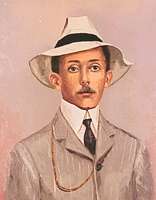Inducted in 1981
First To Fly A Heavier-Than-Air Machine In Europe, 1906
1873 – 1932
Brazilian-born, French-educated Alberto Santos-Dumont achieved the first officially observed powered European flight on October 23, 1906, in France. By flying nearly 200 feet in the “14-bis,” he won the Deutsch-Archdeacon Prize of 3,000 francs for surpassing 25 meters (about 80 feet). On November 12, 1906, he improved upon this performance by flying 722 feet in 21 seconds and won the Aero-Club de France prize of 1,500 francs for the first flight of at least 100 meters (240 feet). This flight fell three years and 150 feet short of what the Wright brothers accomplished in 1903 at Kitty Hawk.
Santos-Dumont was probably one of only a few aviation pioneers who could claim significant accomplishments in both lighter-than-air and heavier-than-air flying machines. His early experiments were in dirigible airships of his own design. After many failures, he built a dirigible that in 1901 won the Deutsch Prize, as well as a prize from the Brazilian government, for being the first to fly in a given time from Saint-Cloud to the Eiffel Tower and return.
In the United States, Wilbur Wright had flown as far as 24 miles by October 1905, but in Europe little progress had been made. Realizing this, Santos-Dumont abandoned lighter-than-air dirigibles and turned his attention to heavier-than-air machines. After two failed attempts, he finally coaxed his awkward biplane, designed on the principle of the box kite, off the ground in October 1906. With this success he became the third man in the entire world to fly a powered aircraft.
A machine he produced in 1909 solidified Santos-Dumont’s reputation as an airplane designer. The famous Demoiselle (or Grasshopper) monoplane was the forerunner of the modern light plane. In 1928 Santos-Dumont returned to Brazil where, depressed over the use of aircraft in war, he committed suicide.

